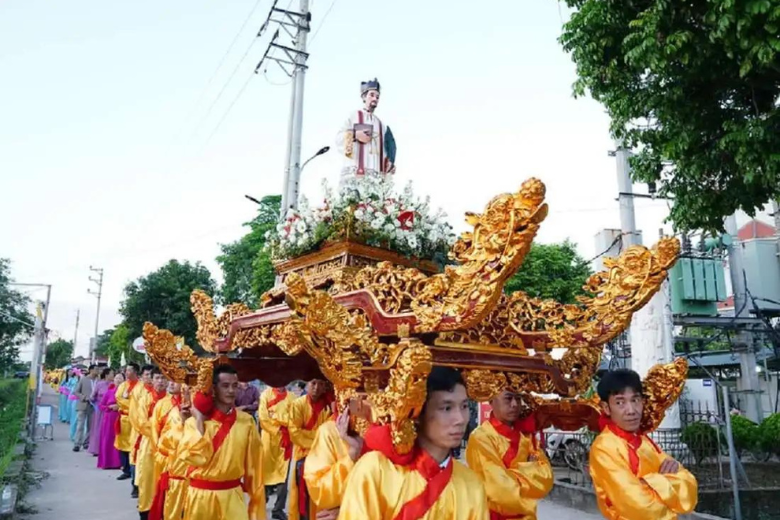Thai King Maha Vajiralongkorn and Prime Minister Prayut Chan-O-Cha visited survivors of the attack in a dark environment made heavy by the crying of family members.
Sittipong Taothawong (left) comforts his wife Kanjana Buakumchan as she holds their child’s bottle and blanket as she stands outside the nursery in Na Klang, northeast Nong Bua Lam Phu province from Thailand on October 7. (Photo: AFP)
Around the small, low building, where just two days ago dozens of preschoolers played, officials in white uniforms with black armbands laid a red carpet for the king’s visit. A line of heartbroken parents placed white roses on the steps of the nursery as the scorching sun set over them in the morning.
Armed with a 9mm pistol and a knife, sacked police sergeant Panya Khamrab opened fire on the day care center in Nong Bua Lam Phu province, killing 37 including 23 children. The attacker committed suicide after killing his wife and child. The 34-year-old policeman was fired for his drug addiction in June.
The Catholic Diocese of Macao has opened its historical archive of nearly one million documents and numerous relics with cultural and heritage values to the public for the first time.
Founded in 1576 as the first jurisdiction of the Catholic Church in the Far East, the Diocese of Macau has preserved for centuries the documents and relics of the Portuguese colonial period from 1557 to 1999. In 2010, UNESCO awarded ancient books at Saint Joseph Seminary and diocesan chancellery archives at its Memory of the World program for the Asia-Pacific region.

A curator polishes a historical relic at the Diocesan Archives of Macau. (Photo: Jornal-O-Clarim)
Founded in 1728, St. Joseph’s Seminary, along with St. Paul’s College, was the main base for missionary work carried out in China, Japan, and other regions. These structures are recognized as heritage sites by UNESCO.
From the 16th century, the Diocese of Macao covered a vast territory in Asia, from Japan to Southeast Asia. Over the centuries, more than 100 dioceses have separated. The diocese has 30,000 Catholics out of the 670,000 inhabitants of Macao.
Hundreds of mourners and survivors on Wednesday commemorated the 20th anniversary of the bombings that killed more than 200 people on the Indonesian resort island of Bali. Family members, survivors and representatives from several embassies attended a memorial in the popular tourist hub of Kuta, Bali, where al-Qaeda-linked militants detonated bombs at a bar and nightclub on October 12, 2002.
The candlelight vigil was held in front of a monument built near the site of the blasts by family members of the victims to mark the country’s deadliest terror attack which killed mostly foreign tourists from more than 20 countries. Australia suffered the greatest loss with 88 dead. The al-Qaeda-linked militant group Jemaah Islamiyah was blamed for the attacks.

A woman prays after laying a flower at a memorial site for victims on the 20th anniversary of the Bali bombings that killed more than 200 people, in Kuta on the Indonesian resort island of Bali on October 12. (Photo: AFP)
Indonesia, the world’s largest Muslim-majority country, has long struggled with Islamist militancy. All the main perpetrators of the Bali bombings have been executed, killed by the police or imprisoned.
However, the planned early release of Umar Patek, who has only served half of his 20-year sentence, sparked an outcry and forced the Indonesian government to suspend the release.
Catholic pilgrims in Vietnam have paid homage to the native saint, Father Peter Le Tuy, who embraced martyrdom for the faith in the 19th century. Thousands of Catholics from the Archdiocese of Hanoi attended a special Mass at the Hanoi City Pilgrimage Center on Tuesday to mark the 189th anniversary of the priest’s death. A hundred priests joined the open-air ceremony on the theme “Saint Pierre Le Tuy – witness to synodality”.
During the two days of celebrations that began the day before, pilgrims attended masses, carried a large statue of the martyr Le Tuy and his relics around the village, watched cultural performances and offered incense and flowers in front of the statue. Twenty-five groups including ethnic women played drums, trumpets and gongs.

People in traditional costumes carry a statue of the martyr Peter Le Tuy around the village of Bang So on October 10. (photo: tonggiaophanhanoi.org)
Born in 1773, Tuy was ordained a priest and served the parishes of Chan Loc, Dong Thanh and Nam Duong. He was arrested on June 25, 1833 by a non-Catholic group after anointing a dying patient with oil.
The priest was beheaded on October 11, 1833 for “spreading heresy among the people”. Pope John Paul II canonized him on June 19, 1988.

